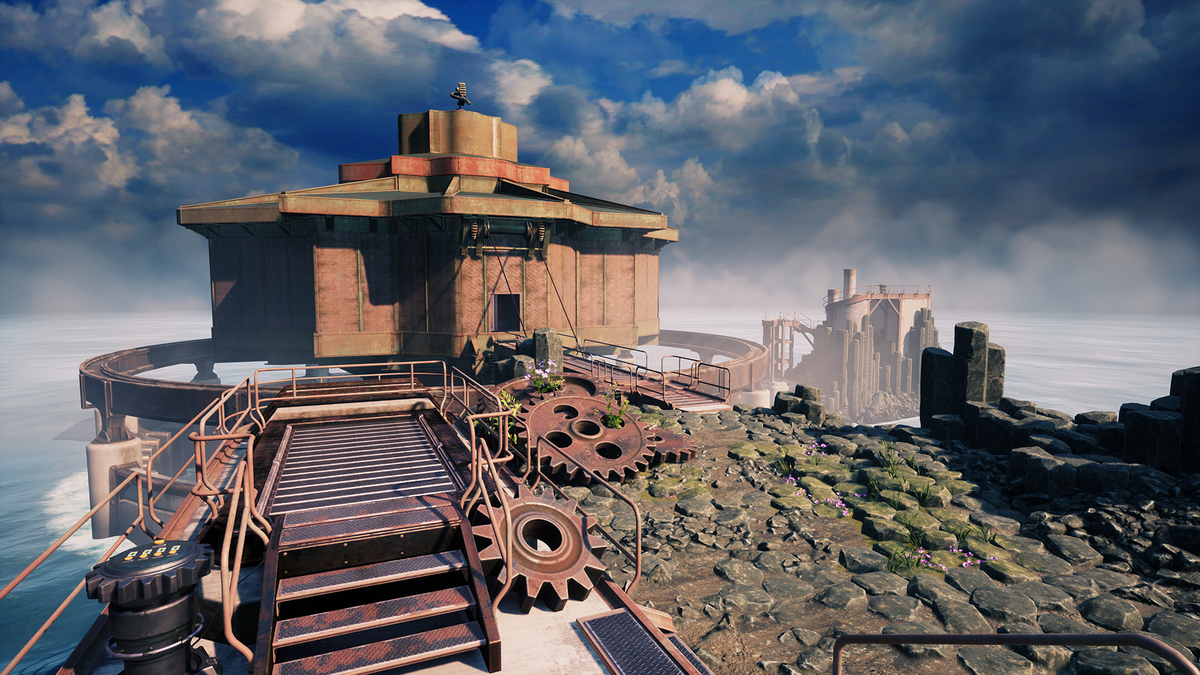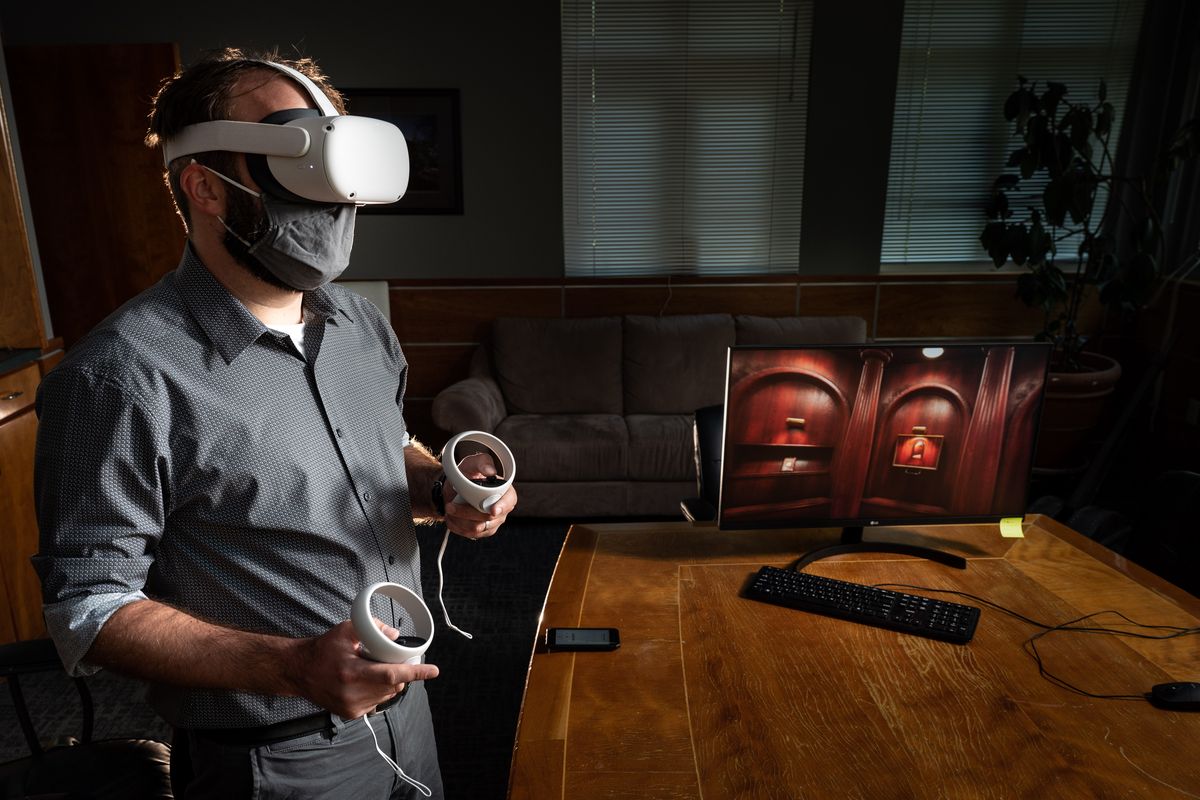Return to ‘Myst’: New version of classic video game from Mead developers releases Thursday
A promotional screen capture shows a scene from a remake of the classic PC video game “Myst.” (Courtesy Cyan Worlds Inc.)
Walking along a bridge of wooden planks toward a water puzzle in the new version of “Myst” that releases Thursday, you may look down and notice a friendly frog hopping at your feet.
Its body bulges briefly, and after a couple of skips, the amphibian splashes into the marsh below.
It’s one of the visual flourishes present in Mead-based developer Cyan World’s most recent revisit to the mysterious-island world that launched Rand Miller and Co. to international fame nearly 30 years ago.
The release, available for $30 for PC, MacOS and Xbox game consoles, marks the first time many fans of the original game and newcomers alike will be able to experience the game in virtual reality, all in an upgraded-graphics engine.
“It’s mesmerizing to me,” Miller said. “I just stand there, sometimes, and stand around and look at things, just because I’m amazed.”
Miller calls Thursday’s release the “definitive version” of the video game that first released in 1993. While the new version will be playable on conventional computer monitors and TVs, it’s the immersive headset that breathes new life into an old classic, Miller said.
“VR is a game changer for me. It makes me feel like I’m in a place,” said Miller, who along with brother, Robyn, created Cyan Worlds in 1987.
The decision to call the remaster simply “Myst” is an intentional one, Miller said.
While past upgrades of the title – which became an instant sensation and prompted multiple sequels with its at-the-time photorealistic visuals, deep storytelling and brainbending puzzles – have included modifiers to the name, such as 2000’s “realMyst,” the team at Cyan was interested in making a game that feels like the first time players plopped the CD-ROM into their drive.
Hannah Gamiel, development director at Cyan, said the team’s goal was to recapture the feeling of the original game for franchise fans while also crafting something new.
“What we’ve been telling people, is we want this to be the ‘Myst’ you think you remember,” Gamiel said. “This is what you picture in your head when you think of playing ‘Myst’ 30 years ago.”
Young players, faced with a new world, may have “filled in some of the blanks” when booting up the game for the first time, Miller said.
For example, players might think they remember clouds in the sky the first time they stepped on the island’s docks during the opening scene of the game. But there were no clouds, just a gray sky.
“We tend to fill in those things, to make it more real for ourselves,” Miller said. “Our goal was to fill in those things for real.”
Another example can be seen when emerging from a bunker early in the game. Gulls circle a sunken galley overhead.
While the new release renders the wings in great detail, the original game had flying creatures that looked like pterodactyls, Gamiel said.
“There were like, conspiracy theories,” she said. “They were like little black marks, flying around.”
Myst was developed from “the ground up” using the popular Unreal engine.
For players, that means detail in the light flickering through trees and the tattered sail of an ancient ship. It also means that ability manipulate cranks and levers for puzzles in a way unimaginable when the game first released.
“You have hands, so we want to make sure you can grab things well and open things that way, but also so things are at eye level,” Miller said. “Because you don’t want to bend down all the time and view controls that are on the floor.”
In the “Channelwood” area of the game, where the frog leaps across the boards, that means levels that were originally on the ground have been turned into cranks at shoulder level.
The game’s ladders also require you to grab and pull, just as you would if you were hoisting yourself on the real thing.
The sensation can be jarring, even nauseating for some players, said Jeff Lanctot, Cyan’s marketing and brand manager.
“It’s so different for everybody,” Lanctot said. “I dove into VR and my first time out was just fine. I gave the headset to my wife, and she was nauseous in an instant.”
To combat that sensation, there are several options for players to reduce the amount of “movement” they experience.
That includes button presses to move the player’s cone of vision, automatic ladder climbs and more.
Even those that have unlocked all of Myst’s secrets can choose to make the experience new.
An option at the beginning of the game will randomize the solutions to all its classic puzzles, Miller said, offering the choice of challenge for new and veteran players alike.
“They’ve got to really play through the game to find those things,” Miller said. “We love that it’s a choice.”
Video game developers have dipped back into their own wells recently for remasters, a way of remaking old titles with new technology for another generation of players.
Recent popular examples include Capcom’s remakes of the classic “Resident Evil” franchise, a reimaging of the first two titles in the popular “Tony Hawk’s Pro Skater” extreme-sports series and an expansion of of genre-defining roleplaying game “Final Fantasy VII” released last year.
Miller said “Myst” has always seemed a likely candidate for a remake, not only because of its popularity upon release but also in setting up Cyan for future VR titles.
Improvements to the team’s software made through development on “Obduction” led to a better experience making “Myst,” Miller said.
The process of making “Myst” will improve the player experience for the team’s next VR game, “Firmament,” which Miller said was running a bit behind schedule due to the pandemic but was still chugging along well.
“I would expect in the next few months you’ll be seeing more from ‘Firmament,’” Miller said.
For now, though, the small team – working partially from home due to the pandemic – will be responding to player feedback when “Myst” goes live Thursday.
The game had previously been available only through the Oculus Quest VR headset, but is expanding to the franchise’s larger PC player base with the release.
Miller said the return to “Myst” demonstrates just how strongly the setting continues to resonate with players.
“Robyn and I, we were just experimenting and we were young, and we really didn’t know what we were doing,” Miller said. “But one of the things we wanted to do was make something that felt like a place. Not just a game, but a place.
“We succeeded, at least partially, and what that means is that people want to keep going back to that place,” he continued.
“And as we make it better, they still are satisfied and fulfilled a little, going back to that place.”

